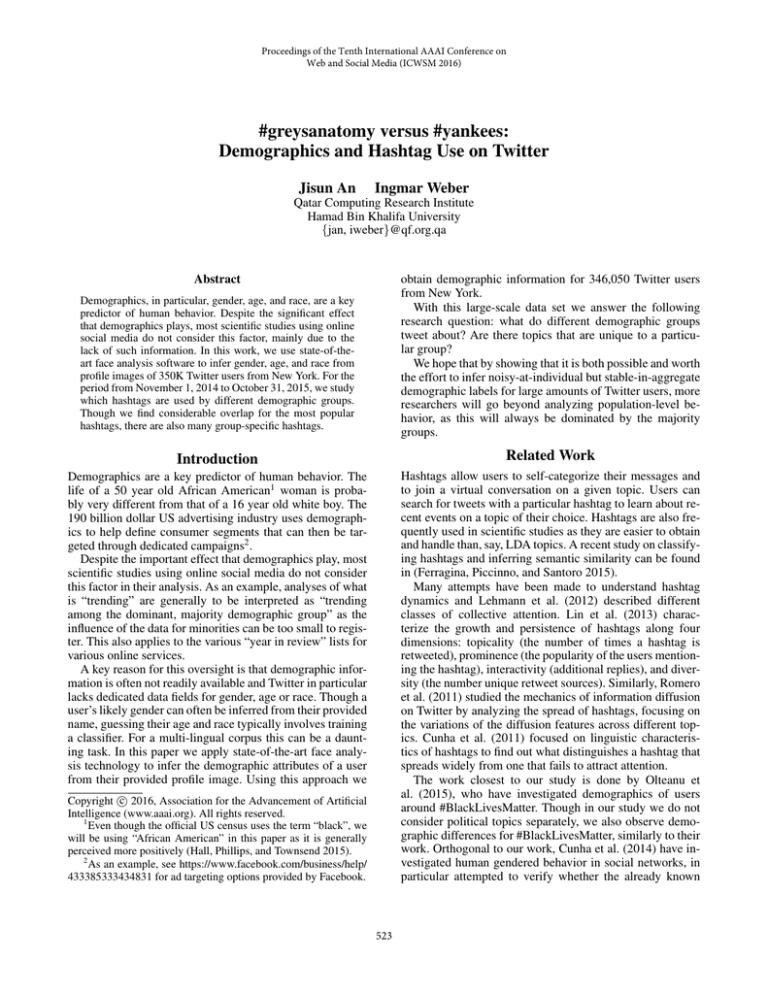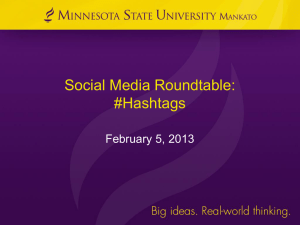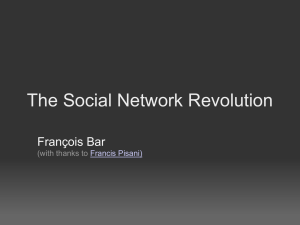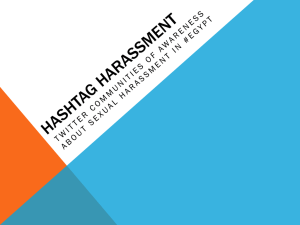
Proceedings of the Tenth International AAAI Conference on
Web and Social Media (ICWSM 2016)
#greysanatomy versus #yankees:
Demographics and Hashtag Use on Twitter
Jisun An
Ingmar Weber
Qatar Computing Research Institute
Hamad Bin Khalifa University
{jan, iweber}@qf.org.qa
obtain demographic information for 346,050 Twitter users
from New York.
With this large-scale data set we answer the following
research question: what do different demographic groups
tweet about? Are there topics that are unique to a particular group?
We hope that by showing that it is both possible and worth
the effort to infer noisy-at-individual but stable-in-aggregate
demographic labels for large amounts of Twitter users, more
researchers will go beyond analyzing population-level behavior, as this will always be dominated by the majority
groups.
Abstract
Demographics, in particular, gender, age, and race, are a key
predictor of human behavior. Despite the significant effect
that demographics plays, most scientific studies using online
social media do not consider this factor, mainly due to the
lack of such information. In this work, we use state-of-theart face analysis software to infer gender, age, and race from
profile images of 350K Twitter users from New York. For the
period from November 1, 2014 to October 31, 2015, we study
which hashtags are used by different demographic groups.
Though we find considerable overlap for the most popular
hashtags, there are also many group-specific hashtags.
Introduction
Related Work
Demographics are a key predictor of human behavior. The
life of a 50 year old African American1 woman is probably very different from that of a 16 year old white boy. The
190 billion dollar US advertising industry uses demographics to help define consumer segments that can then be targeted through dedicated campaigns2 .
Despite the important effect that demographics play, most
scientific studies using online social media do not consider
this factor in their analysis. As an example, analyses of what
is “trending” are generally to be interpreted as “trending
among the dominant, majority demographic group” as the
influence of the data for minorities can be too small to register. This also applies to the various “year in review” lists for
various online services.
A key reason for this oversight is that demographic information is often not readily available and Twitter in particular
lacks dedicated data fields for gender, age or race. Though a
user’s likely gender can often be inferred from their provided
name, guessing their age and race typically involves training
a classifier. For a multi-lingual corpus this can be a daunting task. In this paper we apply state-of-the-art face analysis technology to infer the demographic attributes of a user
from their provided profile image. Using this approach we
Hashtags allow users to self-categorize their messages and
to join a virtual conversation on a given topic. Users can
search for tweets with a particular hashtag to learn about recent events on a topic of their choice. Hashtags are also frequently used in scientific studies as they are easier to obtain
and handle than, say, LDA topics. A recent study on classifying hashtags and inferring semantic similarity can be found
in (Ferragina, Piccinno, and Santoro 2015).
Many attempts have been made to understand hashtag
dynamics and Lehmann et al. (2012) described different
classes of collective attention. Lin et al. (2013) characterize the growth and persistence of hashtags along four
dimensions: topicality (the number of times a hashtag is
retweeted), prominence (the popularity of the users mentioning the hashtag), interactivity (additional replies), and diversity (the number unique retweet sources). Similarly, Romero
et al. (2011) studied the mechanics of information diffusion
on Twitter by analyzing the spread of hashtags, focusing on
the variations of the diffusion features across different topics. Cunha et al. (2011) focused on linguistic characteristics of hashtags to find out what distinguishes a hashtag that
spreads widely from one that fails to attract attention.
The work closest to our study is done by Olteanu et
al. (2015), who have investigated demographics of users
around #BlackLivesMatter. Though in our study we do not
consider political topics separately, we also observe demographic differences for #BlackLivesMatter, similarly to their
work. Orthogonal to our work, Cunha et al. (2014) have investigated human gendered behavior in social networks, in
particular attempted to verify whether the already known
c 2016, Association for the Advancement of Artificial
Copyright Intelligence (www.aaai.org). All rights reserved.
1
Even though the official US census uses the term “black”, we
will be using “African American” in this paper as it is generally
perceived more positively (Hall, Phillips, and Townsend 2015).
2
As an example, see https://www.facebook.com/business/help/
433385333434831 for ad targeting options provided by Facebook.
523
Bio−matching vs. Face++
difference in the linguistic behavior of men and women also
occur in political hashtag use.
Concerning demographics and online behavior in general,
Weber et al. (2010; 2011) looked at web search, Goel et
al. (2012) looked at online browsing, and Malmi and Weber (2016) looked a app usage.
Frequency
100
50
0
Data and Methodology
0
For data collection, we first get a list of users who live in
NY, then we remove those who recently joined or are not
active. We then look at their profile pictures and determine
their age, gender and race. For those who have a detectable
face in their profile image, we collect their past tweets.
20
40
Difference of two results (years)
60
Figure 1: Histogram of the absolute age difference between
the age inferred (i) by Face++ and (ii) using “X years old”
patterns.
Data collection
377,410 Twitter users. The detected gender for these users is
fairly balanced with 51.6% males and 48.4% females. The
majority of the users are detected as “White” (74.4%), but
there are also substantial fractions of “African American”
(12.2%) and “Asian” (13.4%). We group users by their age
in 6 categories: those with an inferred age below or equal
to 17 (denoted as “age-17”), 18 to 24 (age18-24), 25 to 34
(age25-34), 35 to 44 (age35-44), 45 to 54 (age45-54), and
over or equal to 55 (age55-). The majority group is age2534 which entails 37.9% of users, then, age18-24 with 21.9%.
The smallest group is age55- with 2.3%. The general bias
towards younger adults and the very slight skew towards
male users was also observed in a recent Pew Research study
(PewResearch 2015).
Validation of Face analysis. As an easy method to validate how accurate Face++ is in inferring demographic
information, we look at the profile description (i.e. bio)
of Twitter users. We tag users who describe themselves
as “( boy|guy|husband|f ather|dad|dude)” as “Male” and
(
girl|wif e|mother|mom) as “Female”. For age, we look
at users who explicitly mention their age (e.g., “26
yr|yrs|year|years old”).
Concerning gender, we find that of the 2,433 users with
one of the female indicator terms in their bios 82% are recognized as female by Face++. Male has an even higher detection rate–86% of 2,033 males who use one of the male
indicator terms are detected as male by Face++.
For the age inference, the detection rate is lower than for
gender since it is 6-class prediction. Figure 1 shows the
histogram of the absolute difference between the age inferred (i) by Face++ and (ii) by regular expressions. We find
that 25% of them are within 3 year difference and 75% of
them are within 11 year difference. Although age detection
through face analysis is not perfect to tell one’s exact age, we
believe that it is accurate enough to reason about age groups
at the population level.6
Collecting tweets and hashtag. For the 377,410 users
for demographic information could be inferred, we collect
their tweets posted during a one year period (2014/11/01–
2015/10/30) using Twitter’s Restful API. We collected
Twitter Users in NY. For our study, we focus on Twitter
users who live in New York. We made this choice as (i)
we wanted to limit the confounding effect of geographicdemographic changes, (ii) NY has a demographically diverse population, and (iii) there is a large number of Twitter
users in NY. To gather a set of Twitter users living in NY, we
use the “search bio” function of FollowerWonk3 .
We used this function with the query “ny|nyc|brooklyn|
queens|yonkers|(thebronx)|(nuevayork)” for the location field. For this query, we obtained 2,300,357 matching
users in NY from FollowerWonk. For further filtering, we
obtained their Twitter bios using Twitter’s Restful API, resulting in 2,277,456 users. Among them, we choose “active”
users who have at least 10 tweets, joined Twitter more than
3 months ago, and have tweeted at least once in the last 3
months of the data collection period. This process leaves us
with 767,300 users.
Demographic Inference. For these users, we then try to
infer their demographic information, concretely their age,
gender, and race. There are different ways to infer gender: 1) by a gender-based dictionary, often based on census data (Liu and Ruths 2013; Mislove et al. 2011); 2)
by a profile background (Alowibdi, Buy, and Yu 2013); 3)
by tweet content, in particular for non-English languages
where the form of adjectives can often reveal the gender of the speaker (Cohen and Ruths 2013); and 4) by
web services that can be used for this purpose4 . Race can
sometimes be inferred from names (Mislove et al. 2011;
Pennacchiotti and Popescu 2011a; 2011b). Age is harder to
infer and longitudinal tweet histories would typically be required for this task (Nguyen et al. 2013).
We chose to use a single, language-agnostic tool that uses
profile pictures to infer all three variables, age, gender and
race: each profile picture, where present, was passed through
the Face++ API5 . When a face is detected, this API returns
various bits of information, such as a gender, an age estimate, a race, whether a person is smiling or not, etc. We
now discuss this process and its accuracy in more detail.
Face detection. Face++ detects the presence of a face for
49% of the profile images in our data set, leaving us with
3
https://moz.com/followerwonk/
http://genderize.io/
5
http://www.faceplusplus.com/demo-detect/
6
Note that the regular expression does also not have a perfect
precision and it gets fooled by expressions such as “11yr public
school teacher” or “20 years experience in Macintosh support”.
4
524
156,719,072 tweets for 346,050 users (92% of users whose
face was detected). 31,360 users were discarded as they no
longer exist in Twitter or are protected accounts.
Rank
All
Female
African American
age45-54
1
2
3
4
5
6
7
8
9
10
11
12
13
14
15
16
17
18
19
20
nyc
tbt
1
love
2
lovewins
blessed
brooklyn
blacklivesmatter
newyork
ferguson
music
truth
usa
art
superbowl
gopdebate
periscope
neverforget
family
nyc
tbt
1
love
lovewins
2
blessed
blacklivesmatter
truth
brooklyn
ferguson
newyork
art
family
summer
music
superbowl
repost
wcw
grammys
nyc
tbt
1
blacklivesmatter
love
empire
soundcloud
ferguson
np
2
blessed
brooklyn
music
repost
rip
truth
facts
wcw
family
2015
nyc
1
tbt
2
love
usa
periscope
gopdebate
newyork
art
ferguson
brooklyn
ff
blacklivesmatter
lovewins
music
mets
superbowl
truth
travel
Hashtags as Topic Proxies
Hashtags are often good indicators of the topic of a tweet.
Hashtags can be largely self-explanatory (e.g., #sports) or
they can be more cryptic (e.g., #ipl standing for Indian
(cricket) Premier League). In this paper, we use differences
in the hashtag usage between different demographic groups
as an indicator of different topical interests. Conceptually,
our analysis could also be done using LDA-type topics. This
would, however, involve a number of challenges, including
how to avoid that the topics are dominated by the biggest
demographic group.
We extract all hashtags used in these tweets–4,648,929
hashtags used during the one year period. Of course, not all
hashtags were used by many users. In fact, 73% of hashtags
(3,402,625) were used only once. The most popular hashtag
is #nyc and is used by 41,958 unique users.
Table 1: Top 20 hashtags in each group.
age35-44+Female+White (31.5%), age45-54+Female+
Asian (29.4%), age55-+Female+White (29.1%). We find
that there is no statistically significant correlation between
the fraction of tweets with hashtag and the group size–both
Person’s correlation and for Spearman rank correlation tests
showed not significance.
Differences in Twitter Usage
We now look at differences in Twitter usage by marginal
and joint groups. Here “marginal” and “joint” are terms from
multi-variate statistics and refer to (i) only considering one
demographic variable at a time, e.g. females, and (ii) considering a combination of demographic variables, e.g. 18-24
year old white males.
To quantify differences among groups for individual activity levels, we used two measures: the number of tweets
per user and the tweet interval of a user. The tweet interval is approximated by the duration between the first and
the last tweets divided by the number of tweets minus 1. Individual activity levels are not strongly related to the group
size. Across all users, a user posts 447 tweets during the data
collection period on average (minimum is 1, maximum is
5,185 and median is 137 tweets). Asian and African American tweet more than White (the median values are 151, 164,
and 131, respectively). Also younger users are likely to tweet
more than elders (172, 156, 131, 112, 111, 108 from age-17
to age55-, respectively).
Similar patterns are observed for the tweet intervals.
Asian, African American and young users tend to post
tweets within a much shorter interval. The median interval
time is 1.7 days for Asian, 1.6 for African American, 1.6 for
age below 24 and 2.3 for age over 35. Across all users, the
median of access interval is 2.0 days (6.1 days as a mean).
Hashtags usage. Of the 156M tweets in our dataset,
23.9% (37M) contain one or more hashtags. When looking
at marginal groups, the fraction of tweets with hashtag were
similar across race (White (24.7%), Asian (21.7%), African
American (22.1%)) and gender groups (Female (24.4%) and
Male (23.4%)). For age groups, the use of hashtag is increasing for older people (18.8% for age-17 group, then 28.9% for
age45-54 group). This might hint at a more informational,
rather than social use of Twitter for older users.
When looking at joint groups, the top five groups with
the highest hashtag-tweet rates are: age55-+Female+AfrAmerican (39.5%), age45-54+Female+White (32.1%),
Basic observations
The top 20 most popular hashtags. To gain first insights
into how the hashtag usage differs between different demographic groups, Table 1 shows the top 20 hashtags for different groups ranked by the number of unique users. Not
surprisingly, the top hashtag are similar across groups with
the hashtag #nyc being the most popular.
Despite the overlap in the most popular hashtags, there
are also notable differences in the rankings. For example,
#lovewins is 5th for Female but 10th for Male. Regarding
the Ferguson shooting7 , #ferguson made the top 20 list for
all groups, with a ranking between 8th to 13th. #blacklivesmatter, even though related to #ferguson, is used differently
by different groups. It was ranked highest for African American (4th) and lowest for White (19th). A related analysis
was presented in (Olteanu, Weber, and Gatica-Perez 2015).
Some hashtags only make the top 20 of particular groups.
For example, #vmas (a.k.a.,“Video Music Awards”) only appears in the age-17 top 20. For African American the hashtag
#np (9th) for “now playing” is unique and only age45-54 has
#travel (20th). More examples can be found in Table 1.
Most discriminative hashtags: The lists of top 20 hashtags
displayed mostly similarities between the groups. Here we
focus on the group-specific hashtags, specifically on those
with a high Chi-square score (Casella and Berger 2002)
for discriminating between the group and the non-group
(e.g., Female vs. Non-Female (Male) or Asian vs. NonAsian). Table 2 shows the top 20 hashtags ranked by Phi,
the Chi-square test statistics. For most groups the discriminative terms are intuitive such a #asianamerican for Asian or
#growingupblack for African American.
7
525
https://en.wikipedia.org/wiki/Shooting of Michael Brown
Rank Female
Male
Asian
African American
White
1
2
3
4
5
6
7
8
9
10
knicks
nfl
jets
mets
nbafinals
nba
soundcloud
sctop10
mlb
yankees
freshofftheboat
aldubebforlove
aldubebtamangpanahon
aldubmostawaiteddate
kpop
aldub
asian
ootd
thepersonalnetwork
asianamerican
empire
empirefox
growingupblack
blacklivesmatter
facts
betawards2015
betawards
sandrabland
soundcloud
np
nyr
sabres
buffalo
bills
usa
nhl
billsmafia
snl40
onebuffalo
mets
Rank age-17
age18-24
age25-34
age35-44
age45-54
age55-
1
2
3
4
5
6
7
8
9
10
goals
relationshipgoals
todayskidswillneverknow
mcm
wcw
blessed
vmas
pll
growingupwithsiblings
tbt
nyc
brooklyn
latergram
nofilter
broadway
newyork
summer
inspiration
sunset
tbt
leadership
innovation
data
bigdata
iot
constantcontact
mobile
analytics
jobs
digital
tcot
iran
p2
pjnet
irandeal
china
leadership
gop
constantcontact
8217
tcot
irandeal
p2
pjnet
ccot
constantcontact
uniteblue
googlealerts
iran
ibdeditorials
love
makeup
greysanatomy
lovewins
beauty
pll
girlpower
nyfw
internationalwomensday
sisters
dontjudgechallenge
todayskidswillneverknow
growingupwithstrictparents
nowimmad
growingupagirl
growingupwithsiblings
pll
kca
ifwedate
teenchoice
Table 2: Most discriminative hashtags for each group, ranked by Phi.
Conclusions
Lehmann, J.; Gonçalves, B.; Ramasco, J. J.; and Cattuto, C. 2012.
Dynamical classes of collective attention in twitter. In WWW.
Lin, Y.-R.; Margolin, D.; Keegan, B.; Baronchelli, A.; and Lazer,
D. 2013. # bigbirds never die: Understanding social dynamics of
emergent hashtag. In ICWSM.
Liu, W., and Ruths, D. 2013. What’s in a name? Using first names
as features for gender inference in Twitter. Analyzing Microtext:
2013 AAAI Spring Symposium.
Malmi, E., and Weber, I. 2016. You are what apps you use: Demographic prediction based on user’s apps. In ICWSM.
Mislove, A.; Lehmann, S.; Ahn, Y. Y.; and Onnela, J. P. 2011.
Understanding the Demographics of Twitter Users. ICWSM.
Nguyen, D.; Gravel, R.; Trieschnigg, D.; and Meder, T. 2013.
“How Old Do You Think I Am?” A Study of Language and Age in
Twitter. ICWSM.
Olteanu, A.; Weber, I.; and Gatica-Perez, D. 2015. Characterizing the demographics behind the# blacklivesmatter movement. In
OSSM.
Pennacchiotti, M., and Popescu, A. 2011a. Democrats, republicans
and starbucks afficionados: user classification in twitter. In KDD.
Pennacchiotti, M., and Popescu, A. 2011b. A machine learning
approach to twitter user classification. In ICWSM.
PewResearch.
2015.
The Demographics of Social Media
Users. http://www.pewinternet.org/2015/08/19/the-demographicsof-social-media-users/. Online; accessed 6th January 2016.
Romero, D. M.; Meeder, B.; and Kleinberg, J. 2011. Differences
in the mechanics of information diffusion across topics: idioms,
political hashtags, and complex contagion on twitter. In WWW.
Weber, I., and Castillo, C. 2010. The demographics of web search.
In SIGIR.
Weber, I., and Jaimes, A. 2011. Who uses web search for what:
and how. In WSDM.
This paper is the first large-scale study presenting details on
how different hashtags are used by different demographic
groups on Twitter. Aggregated across a whole year the most
popular hashtags are largely similar for all groups. Our work
shows that a population-level analysis of hashtags and trends
on Twitter is likely to miss the complexities induced by
demographic-specific behavior.
References
Alowibdi, J. S.; Buy, U. A.; and Yu, P. S. 2013. Language independent gender classification on twitter. In ASONAM.
Casella, G., and Berger, R. L. 2002. Statistical inference, volume 2.
Duxbury Pacific Grove, CA.
Cohen, R., and Ruths, D. 2013. Classifying Political Orientation
on Twitter: It’s Not Easy! In ICWSM.
Cunha, E.; Magno, G.; Comarela, G.; Almeida, V.; Gonçalves,
M. A.; and Benevenuto, F. 2011. Analyzing the dynamic evolution
of hashtags on twitter: a language-based approach. In Proceedings
of the Workshop on Languages in Social Media, 58–65. Association for Computational Linguistics.
Cunha, E.; Magno, G.; Gonçalves, M. A.; Cambraia, C.; and
Almeida, V. 2014. He votes or she votes? female and male discursive strategies in twitter political hashtags. PloS one 9(1).
Ferragina, P.; Piccinno, F.; and Santoro, R. 2015. On analyzing
hashtags in twitter. In ICWSM.
Goel, S.; Hofman, J. M.; and Sirer, M. I. 2012. Who does what on
the web: A large-scale study of browsing behavior. In ICWSM.
Hall, E. V.; Phillips, K. W.; and Townsend, S. S. 2015. A rose
by any other name?: The consequences of subtyping “africanamerican” from “black”. Journal of Experimental Social Psychology 56:183–190.
526






